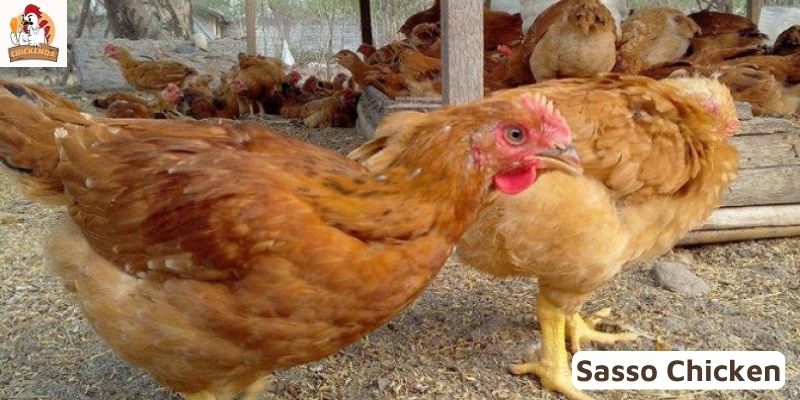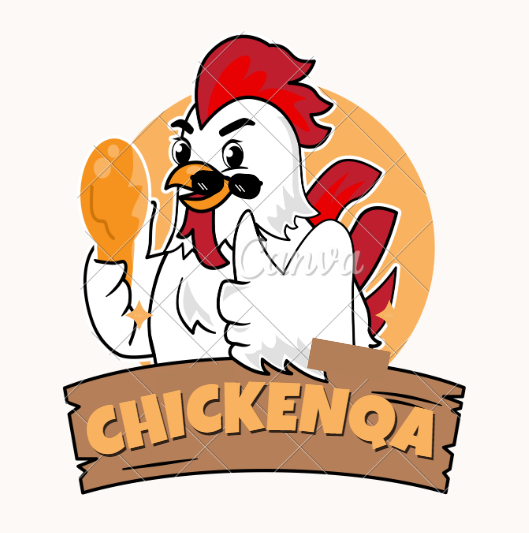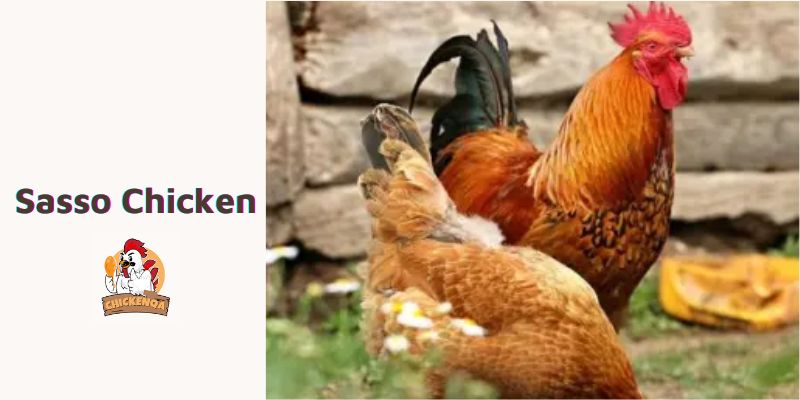In some places, country chicken is preferred over the Butterball look. Another choice that falls in between Jackie and the Freedom Ranger is Sasso Chicken. This multicolored bird, which has lighter, speckled feathers and a heavier body than the Freedom Ranger, will reach market weight a few days later. This breed will bring personality to your free-range farmyard, backyard, or grill company and was hatched and transported straight to you from our family hatcheries. Chickenqa.com will provide you with some background knowledge and general Sasso Chicken facts in this article. In addition, we offer advice on how to raise well.
SASSO Chicken Background

The native chicken breeds were to be preserved, according to southern Frenchman Serge Perrault in the 1950s. The Sasso T lines are a result of his work. When participating in the establishment of the “Label Rouge” criteria for conventional chicken, a cooperative of farmers from the same region initiated a project that eventually resulted in the founding of SASSO.
To facilitate the export of the SASSO breeds, SASSO developed a second location close to the airport in the 1990s. In 2016, SASSO and Hendrix Genetics agreed to a partnership that resulted in a partnership in 2017. As of 2017, Hendrix Genetics serves as a backup for all worldwide SASSO breeding grandparent stock efforts. Both SASSO and Hendrix Genetics benefited from them; SASSO gained a global presence while Hendrix Genetics added to its excursion into traditional poultry breeds, which it began in 2013.
Through Tanzania’s Silverlands Company, which sells SASSO day-old chicks through local distributors in Kenya, SASSO breeds are made available in that country.
Breed Information for Sasso Chickens
The SASSO developed the “Label ROUGE” concept in 1965, which gives their breeds their strength. Label Rouge is used as a quality certification symbol to demonstrate that the birds were grown under specific guidelines. Label Rouge-certified chicken goods have the Label Rouge Sticker on them, which has a unique identifying number that makes it simple to follow the product’s journey from the farm to the store shelf.
Label Rouge is founded on the following 5 tenets:
- Breeds that can handle challenging outdoor circumstances.
- Free-range chicken is reared outside or in good space per bird. According to the specification, outdoor space is equal to 2 square meters per bird, and free-range space is unrestricted. The maximum number of birds per square meter should be 11, with lower densities being preferred when housed inside.
- A diet that is entirely plant-based and contains up to 75% grains as well as plant protein.
- Slow-growing guarantees a steak with a firm texture and outstanding flavor. The beef items should feel excellent to the touch, taste good, look good, and smell good.
- A safe and healthy environment for growth.
The SASSO chicken breeds SASSO Rainbow T (TR), SASSO Rainbow X (XR), SASSO Ruby C(C44), SASSO Ruby N(XL44N), and SASSO Ruby T(T44) are accessible in Africa due to their ability to endure the African poultry-keeping conditions.
Unlike the other chickens, the Ruby T is intended to be a dual-purpose bird for meat and eggs. Additionally, Sasso offers the SA51, SA31A, and SA31L, which are intended for breeding.

Sasso Chicken farming management firm
1. SASSO Day-Old Chick Sourcing and Receiving
Several day-old chick-selling businesses with headquarters in Kenya provide SASSO day-old chicks for sale. Make sure the Chicks are imported directly from Tanzania’s Silverlands. This will guarantee that you only receive premium SASSO F1 girls.
Make sure your brooding area is ready before receiving the SASSO day-old chicks. It ought to be cleaned, refilled with fresh litter, and set up with clean feeding and drinking trays. Verify that the heat source is operating as it should. For SASSO chicks, the typical brooding procedure is used, as demonstrated below.
2. Keeping Sasso Chickens Safe and Clean
Make careful to adhere to the typical chicken house recommendations for better productivity. Raising systems for SASSO chicken include deep litter, semi-free-range, and full-range systems. The SASSO chicken house should provide security for them and shield them from bad weather.
3. Chicken Sasso Vaccination Schedule
To ensure your SASSO chicken’s highest level of productivity and overall health, make sure you adhere to accepted standards for poultry hygiene and biosecurity. Additionally, you must adhere to the local SASSO immunization schedule.
Please be aware that there isn’t a universal chicken vaccination schedule that applies to all regions. India needs different immunizations than Kenya or Europe does. Different vaccines are given in various locations even in some countries. The most common diseases in a specific area are used as the basis for vaccination programs.
The Kienyeji chicken immunization program should be followed in Kenya for SASSO chicken vaccination.
3. Program for Sasso Chicken Feeding

If you feed your SASSO chicken properly, you may be confident that it will reach the proper weight at the appropriate time.
Please be aware that, unlike regular broilers, SASSO broilers are designed to grow more slowly. As a result, you shouldn’t try to use grill finisher feeds to accelerate growth. The birds need to achieve market weight in 9–10 weeks, not earlier, in order to obtain the superior flavor and texture of SASSO meat. This guarantees that the muscles grow slowly and effectively, achieving a texture and flavor that are comparable to that of traditional Kienyeji chicken.
For roughly three weeks when the Sasso chicken is in the brooder, complete food for meat chicken should be given. You have the option of using commercial feeds or creating your own.
Allow your SASSO chicken to forage for their own food (free-range) after three weeks. The SASSO chickens’ exposure to the range aids in their development of the necessary muscle texture for premium traditional chicken meat. 80% of the food needed for SASSO broilers should be fed in the morning and evening for optimal growth. For the remaining 20%, the SASSO birds should be able to scavenge.
4. Keeping Records for SASSO Chicken
Maintaining accurate records can help you keep track of your SASSO chicken’s production, costs, and earnings. This will enable you to determine whether your SASSO chicken business is profitable. You can compute the Feed Conversion ratio for your SASSO broilers using records like weight gain and feed consumption.
5. Promotion of SASSO Chicken
SASSO broilers are prepared for the market at around 9–10 weeks. At this point, the weight should be between 1.5 and 2 kilograms. Before beginning to raise SASSO chicken, it is necessary to have an idea of your target market. This guarantees that you rear the birds to their proper market weight.
In some places, country chicken is preferred over the Butterball look. Another choice that falls in between Jackie and the Freedom Ranger is Sasso Chickens. This multicolored bird, which has lighter, speckled feathers and a heavier body than the Freedom Ranger, will reach market weight a few days later. This breed will bring personality to your free-range farmyard, backyard, or grill company and was hatched and transported straight to you from our family hatcheries. Chickenqa.com will provide you with some background knowledge and general SASSO chicken facts in this article. In addition, we offer advice on how to raise kids effectively.


